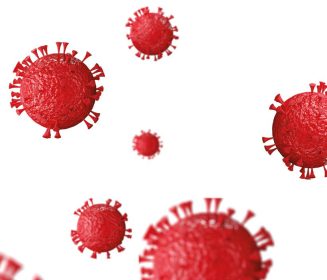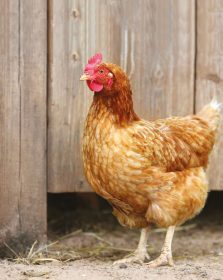
Vaccination against AI seems within reach
There’s no need to explain to what extent Avian influenza (AI) affects the global poultry business. This highly contagious and lethal avian disease causes not just massive economic damage, but as a zoonotic disease also threatens human health. Pharmaceutic companies are making progress however, to develop vaccines against AI. Wageningen Bioveterinary Research (WBVR), part of Wageningen University & Research in the Netherlands, tested four of such possible vaccines. After laboratory research, two of these vaccines seem promising, says researcher Evelien Germeraad of WBVR.
There’s not just one strain of Avian influenza (AI) to combat. In the last decade there were different subtypes of highly pathogenic avian influenza virus, according to Evelien Germeraad. Together with a number of other specialists, Evelien belongs to the research team at Wageningen Bioveterinary Research (WBVR) in Lelystad (Netherlands), the institute that currently investigates the effectiveness of possible vaccines together with partners from Utrecht University and Wageningen University.
“If we go back to the year 2003, the High Pathogenic (HP) H7 AI strain severely struck the poultry business in The Netherlands”, says Evelien. In those days about 30 million birds were culled by the Dutch authorities to combat and prevent further spreading of the disease. In the year 2014, there was another outbreak, this time caused by a HP H5N8 virus. Poultry at 5 farms was infected. From 2016 until 2020 several farms were infected.
“The most recent outbreak started in October 2021 and is not officially under control yet (May 2023). This outbreak is much more severe and the largest outbreak in Europe thus far. Millions of birds were culled since the virus was first detected, not just in The Netherlands, but across Europe. And HPAI is not limited to Europe only, but spread to all corners of the world. It is truly difficult to eradicate”.
- The AI virus H5N1 that circulates at the moment originates from waterfowl from Siberia. These birds migrate to more southern located countries in Europe during the winter season. Here, these birds reside under milder conditions. These migrating birds convey the disease with them, affecting poultry flocks, either by their droppings during the flight, or in the vicinity of where they accommodate. “
- Due to current and future welfare insights, a number of commercial poultry flocks partly reside outdoors nowadays. This makes these flocks an easy “target” for AI, carried by the wild birds. For this reason, the Dutch ministry of Agriculture has ordered in October 2022 that all Dutch poultry should be kept indoors. This regulation still holds.
- From a welfare point of view, here we see the friction between the current desire in Europe to keep poultry under outdoor conditions and the increased risk of HPAI infection. Thus, there’s much reason to take appropriate measures.
- The immediate measures, conducted by the ministry of Agriculture, include the obligation of the farmer to keep the flock indoors, usually preventive culling of farms in the vicinity of an infected farm and installing zones in the country where transportation of live birds is prohibited.
“Despite the comprehensive biosecurity program, strict hygiene measures and the shielding obligation, the bird flu virus was detected in around 60 Dutch poultry farms during 2022-2023,” Evelien continues.

The virus remained present year round, hitting both commercial farms and wild birds.
Also, normally during the summer season with higher temperatures, abundant presence of UV light and the return of wild birds to their breeding grounds, AI usually “extinguishes” and seems to disappear. This wasn’t the case this time. The virus remained present year round, hitting both commercial farms and wild birds. In wild birds not only the migrating birds, but also non-migrating species such as seagulls and storks were subject to the AI infection in 2022.
“Recent data show that the shielding obligation combined with the biosecurity and hygiene measures taking by commercial poultry farmers in the Netherlands, have proven effective in keeping the bird flu virus at bay. The last bird flu case on a commercial farm was registered in January of 2023. In wild birds however, we continue to detect the H5N1 virus in different species. We are closely monitoring the situation and are anxious to see how the disease will develop through the next summer period.”
The demand for an effectively working vaccine is growing
As a result of this ongoing situation, logically the demand for an effectively working vaccine is growing. Not just in The Netherlands or in Europe, but across the globe. After all, the consequences and the impact of AI are dramatic, both from an economic – as well as from a (public) health point of view.
- Yet, this is not as easy as it sounds. Firstly, there are various variants of HPAI viruses.
The genetic composition of AI virus in the USA for example, is different from Europe and Africa and again different that the virus in Asia or Africa. Moreover, a virus can relatively easy mutate into sometimes new strains. Think in this context about the “survival of the fittest”.
- And not just that. A vaccine against current and future HPAI H5 avian influenza viruses that can be used to protect poultry, must meet several conditions for use.
- The vaccine (in combination with another vaccine) must be effective in reducing virus transmission (Replication factor R<1) under field conditions and fit into the current vaccination program for poultry. The objective is to avoid “silent spread” of HPAI H5 viruses.
It should also be possible to conduct monitoring and surveillance programs to determine whether poultry are adequately protected by vaccination and whether no avian influenza virus is present.
In addition, it must be possible to serologically distinguish vaccinated animals from infected animals according to the DIVA principle (Differentiating Infected from Vaccinated Animals).

Under these conditions, research at Wageningen Bioveterinary Research to find an effective vaccine, is currently taking place and this seems promising. Four vaccines were tested under laboratory conditions among layers, which were by injection vaccinated with vaccines, developed by four different pharmaceutics companies.
- The conclusion of this study is that two HVT-H5 vaccines meet the predetermined conditions in an experimental environment, under which these vaccines were tested.
- Virus transmission for both vaccines was significantly reduced relative to the unvaccinated control group and the replication factor R was significantly smaller than 1 (R<1).
- The chickens were completely protected from disease after infection with the HPAI H5N1 virus.
- The vaccines comply with the DIVA principle and can be administered in ovo (in the egg) or by injection subcutaneously to day-old chicks in the hatchery.
- This type of vector vaccine is known to be effective only in chickens and turkeys.
The next step will be testing laying birds under field conditions at an age of 8 weeks. This research, commissioned by the Dutch ministry of Agriculture and the poultry sector, is currently being set up by WBVR in conjunction with the University of Utrecht, Wageningen University and the Animal Health Service (Gezondheidsdienst Dieren). Most likely this will generate useful additional results.
Hence, the development of a vaccine against HPAI virus seems to have made a major step forward. Someday, it must be possible to protect poultry across the globe against contagious High Pathogenic Avian Influenza virus. The first steps have been taken. “We keep moving on to eventually find the answer”, Evelien Germeraad concludes.
Source: avinews.com


















